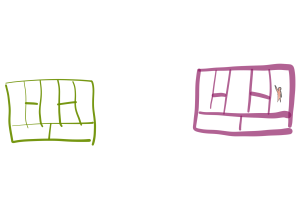A company never creates value in isolation. There are always other companies involved in some way to realising and delivering the final product for the customer. Such value chains of companies optimise connections on their complementary capabilities, which enables each to focus on what they’re good at.
The composition of a car is a good example here. Car manufacturers design, and assemble cars under their own brand. But all the parts required for assembly come from different suppliers (for pistons, suspension, braking technology, seat manufacturing, etc), and distribution & sales of the car to the final customer is done through networks of car dealers.
Value chain analysis is great for supporting business as usual. However, when you need to shift your business to a seemingly similar, adjacent customer segment (as is often case in today’s turbulent business environments), the value chain’s usefulness breaks down. The solution lies in framing partnership relations in a different way, as I’ll explain in this article.
The Functional Value Chain
Value chain analysis is a great way to understand production systems. You sketch out the value chain for the product from its origin to the end consumer. The value chain shows the companies involved in value creation, and the sequence in which value creation is achieved.

The linkages in the value chain can be used to describe the relation between each company in that chain. The value chain is a great tool to examine how and where value is created, and where the risks in the production system reside.
The Disfunctional Value Chain
The value chain approach works well for analysing very formalised, industrial production systems with a clear hierarchy in the organisation of production. But the knowledge that comes from analysing the value chain gives an elusive sense of control about the ability to actually change a production system.
The instant you want to focus on a different customer segment, or change your value chain, because a partner role is not contributing value (or has become obsolete) you start sensing the illusion. Change takes more than replacing some of the mechanics in a sequential production system.
When changing your company, and changing the value chain with it, you see that in reality you are part of a complex, highly interdependent, nested production network, that is designed to drive value creation towards a very narrow purpose.

Attempts to focus on a customer segment outside of the scope of that system flushes up restrictive dependencies, and the configuration’s immune system will have you ousted, rather than change with you. You’re on your own!
This is what Unilever experienced with the recent hostile take-over bid from competitor Kraft. Though Unilever, and its customers are on a change route to sustainable consumption, shareholders remain with their demand of maximising shareholder value. The Kraft bid showed how Unilever has set each foot in a different value network, and that this inconsistency can painfully split a company.
Changing Partner Relations
Professor Tim Kastelle said it well:
“not only do our end users have to prefer our idea, but we also have to get others within the value network to stop using [and supporting] our competitors”.
In order to change your business model to serve a different customer segment, you need to draw in partners involved in other value networks, and lure them to investing resources into yours.
To achieve this, the perspective on partnership relations needs to shift from that of value chain efficiency, and scale, to that of value network discovery, and growth. This entails that partnership relations shift from tweaking business model efficiency, to a joint search for creating, delivering, and capturing new value.
This shift can be seen in Amazon’s partnership with an air freighter. It’s not that existing value chain partners like UPS, and Fedex aren’t able to work to the particular requirements of Amazon’s operations. It’s more so that Amazon’s B2C customer segment is adjacent to UPS, and Fedex’s existing core B2B customers. They have different demands regarding delivery rhythms, volumes, and shipping rates than Amazon’s customers.
The Business Model, and Partnership Canvas: Tools that change Perspective
The objective is to define the logic of tying 2 business models together in an exercise of joint value creation. Search is required to figure out how you can collaborate in such a way that both your, and your partner’s business benefit from this new value.

Partnership Design, which is based on Alexander Osterwalder’s Business Model Canvas, and my Partnership Canvas, provides a way for achieving this. Partnership Design frames partnering as a business model innovation challenge. It brings focus to value inputs that partners can respectively bring to the table to jointly create a new form of value for delighting customers.

By focussing on the potential of synergy between value offered, and value desired from each partner, discussions on relationships are framed around the merit of their creative potential. It allows thinking to escape the trap of conventions of efficiency in partnership relations, and upfront disqualification of new linkages due to differences in company size, market power, and assumptions about where industry boundaries lie.

By looking at your partners one-by-one, you can start to gradually reassemble your value network, around a new customer segment.
The Business Model, and Partnership Canvas help teams to quickly flesh out key hypotheses. These need to be tested to verify whether the new relationship will add value to both their partner’s, and their own business model at the same time.
Continue the exercise for all the partners that you’ll need to build the value network, and watch the ripple effects change an industry!
Interested to learn more about Partnership Design?
Check out Training opportunities!
or
You can join the Partnership Design Linkedin group!
Further inquiries? Send an email to: info@partnershipcanvas.com
